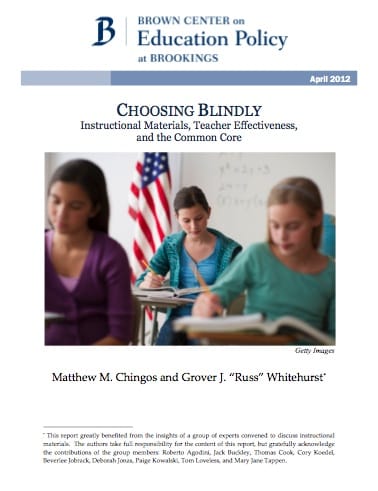 This latest missive from Brookings’s Brown Center on Education Policy hits hard from paragraph one: It questions the priorities of education policymakers and offers sharp, actionable recommendations for how to realign them. According to authors Matt Chingos and Russ Whitehurst, “There is strong evidence that the choice of instructional materials has large effects on student learning—effects that rival in size those that are associated with differences in teacher effectiveness.” But few focus adequately on strengthening and evaluating instructional materials, instead dispensing far too much energy on the “context” of education (including governance arrangements, collective-bargaining agreements, and teacher-evaluation systems). This omission is even more onerous in the Common Core era: Without rigorous instructional materials linked to those new standards, they will not likely lead to noteworthy student improvement. To remedy this, Chingos and Whitehurst offer sound recommendations geared to various stakeholders: First, state education agencies should collect and report data on their districts’ instructional materials. To make this happen, national foundations should provide seed funding, the National Center for Education Statistics should offer guidance, and the Data Quality Campaign should act as watchdog. Second, the National Governors Association and the Council for Chief State School Officers—both highly invested in seeing the Common Core succeed—should collect data on best CCSS-aligned instructional materials. Kudos to the Brown Center for once again airing a contrarian—and spot-on—concern. Even Kate Walsh agrees.
This latest missive from Brookings’s Brown Center on Education Policy hits hard from paragraph one: It questions the priorities of education policymakers and offers sharp, actionable recommendations for how to realign them. According to authors Matt Chingos and Russ Whitehurst, “There is strong evidence that the choice of instructional materials has large effects on student learning—effects that rival in size those that are associated with differences in teacher effectiveness.” But few focus adequately on strengthening and evaluating instructional materials, instead dispensing far too much energy on the “context” of education (including governance arrangements, collective-bargaining agreements, and teacher-evaluation systems). This omission is even more onerous in the Common Core era: Without rigorous instructional materials linked to those new standards, they will not likely lead to noteworthy student improvement. To remedy this, Chingos and Whitehurst offer sound recommendations geared to various stakeholders: First, state education agencies should collect and report data on their districts’ instructional materials. To make this happen, national foundations should provide seed funding, the National Center for Education Statistics should offer guidance, and the Data Quality Campaign should act as watchdog. Second, the National Governors Association and the Council for Chief State School Officers—both highly invested in seeing the Common Core succeed—should collect data on best CCSS-aligned instructional materials. Kudos to the Brown Center for once again airing a contrarian—and spot-on—concern. Even Kate Walsh agrees.
Matthew M. Chingos and Grover J. “Russ” Whitehurst, Choosing Blindly: Instructional Materials, Teacher Effectiveness, and the Common Core (Washington, D.C.: Brown Center on Education Policy at the Brookings Institution, April 2012).
